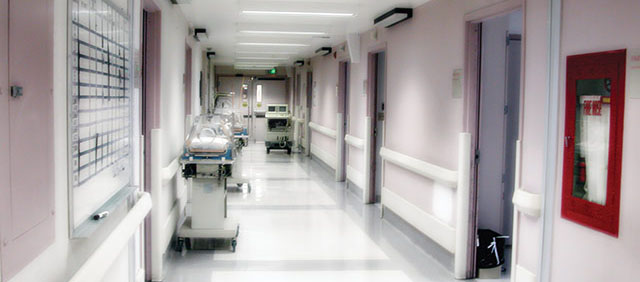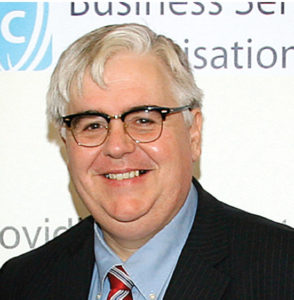Exploiting technology for better procurement

 Assistant Director of Procurement and Logistics at the Business Services Organisation, Peter Wilson talks to David Whelan about the positive impact technology has had on the improvement of procurement and logistics within the health service over the last decade.
Assistant Director of Procurement and Logistics at the Business Services Organisation, Peter Wilson talks to David Whelan about the positive impact technology has had on the improvement of procurement and logistics within the health service over the last decade.
As a former Director of Procurement for the health service, Peter Wilson oversaw the 1997 sharing of services across Northern Ireland’s healthcare, a move which paved the way for a more efficient introduction of technology across a common system, even if it was a dated system lifted from the UK.
“Those systems were typically very rigid, you could put lots of data into them but you couldn’t get much out of them. They were essentially just automations of the traditional systems we had been using,” said Wilson. “They were manually intensive and simply replicated a process that whereby a written requisition was produced on the ward and it might have taken weeks before collection and delivery. It was typically ‘1980s green-screen technology’ and we lived with that until around 2006 when in my former role we implemented trying to automate some of that manual workload and bought a cheap and cheerful system from a local company. The system wasn’t comprehensive, it couldn’t deal with anything that wasn’t in the central catalogue and it was piecemeal, but it marked the beginning of change. In parallel to that change we introduced our Electronic Material Management (EMM) solution which reinvented the stock replenishment system across 391 clinical areas of health in Northern Ireland.”
Health had introduced Electronic Data Interchange (EDI) to their warehouses prior to 1997 but in October 2012 the implementation of the Business Systems Transformation Programme, a wider replacement of systems within the health service, dramatically altered how technology was being exploited for the benefit of procurement in health.
“The intention was to deliver cost benefits and the reality was that the old green screen technology was a burning platform which we were struggling to maintain and needed to modernise. It was data rich but information light. So we needed a substantial modernisation and the establishment of a wider set of shared services beyond just procurement and logistics. The idea was to bring in new systems and drive efficiency in those shared services. We delivered our efficiencies by growth, we saw very significant growth over a period of time which the new systems helped us cope with. In other areas it was about changing and streamlining for efficiency while reducing the resources required to do that.”
The new system brought more familiarity, bringing about a 100 per cent shift to electronic orders and transactions and significantly reducing waiting times for goods. However, it also represented a big culture shift for users and as Wilson admits, it was far from the “Amazon experience”.
“It was difficult because we weren’t in a position to invest in an Amazon type. The look and feel was not ‘generation now’,” he explained. “What we invested in delivers what we needed it to do, it does all of the features. It just doesn’t have that look and feel. However, we are about to go live later this year with an update that will hopefully make it even more user friendly. I think the success is in the numbers, 76 per cent of transactions that we deal with are now taken from our online catalogue.”
Business
Another key benefit that technology has offered in the health sector is the introduction of upstream tendering through the eTendersNI portal, which provides opportunities to provide goods, services and works to Northern Ireland government department, agencies and arms-length bodies. Despite fears that eTendering would be detrimental to Northern Ireland SME’s, of the 2,300 live contracts the BSO procurement and logistics service operate, 74 per cent are SMEs and 43 per cent are Northern Ireland based SMEs.
“Unsurprisingly we’ve always done a lot of business with Northern Ireland SMEs because it is the nature of our market. I’m not sure the SMEs would have the same positive reaction to eTendering. The supplier base generally needs to be prepared to respond to tenders electronically. The Public Contracts Regulations 2015 and the European Union directives are driving public organisations towards mainstreaming documentation electronically. I think SMEs can find this challenging, especially if they don’t have the resources of big business. However, the upside is that it offers opportunities to everyone and the fact is that SMEs constantly win business from us, so they are adapting pretty well.”
Looking to the future Wilson said that the aim is to exploit the technology further by carrying out more in depth analysis of statistics for further savings. He said that currently around 1 per cent of the value of service that the analysis could be delivered as a saving. Last year the BSO recorded £15 million worth of savings throughout health and already this financial year they have recorded £5 million, £4 million of which is through electricity.
“Challenges for us in trying to deliver savings is that we have been active in competition in the marketplace for a long time now. Savings over the years have become more modest because it’s more challenging to make them and it will be interesting to see, through deep dive analysis, if technology has allowed us to change behaviours and to reflect what we are finding, or if we are driving standardisation.”
“Some of our more long-term aims include the user-friendly upgrade, we’re looking into online evaluation on eTendering, as well as a system of self-receipting to ensure quicker payments for the provider. Cloud billing is also something under consideration but that will need weighed up against any potential cost the provider may incur. In terms of integrating into our system we have legislation coming down the line for Unique Device identifiers (UDI) to be implemented.”





